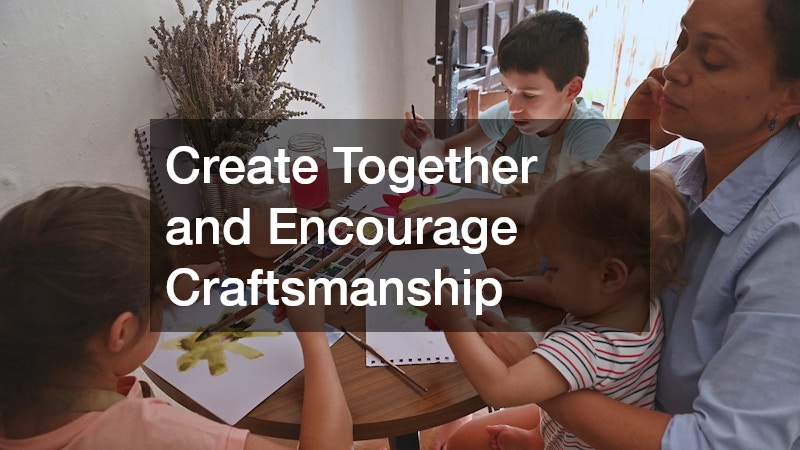Building a strong family bond doesn’t happen overnight—it takes shared experiences, learning opportunities, and plenty of laughter along the way. Families that engage in activities together not only stay active and healthy but also build trust, cooperation, and lasting memories.
Whether it’s through sports, hobbies, or giving back to the community, spending quality time with loved ones encourages teamwork and emotional connection. From mastering new skills to embracing the outdoors, there are countless ways to grow closer while having fun.
Here are ten meaningful ways families can strengthen their bonds through learning, fitness, and adventure—all while discovering new passions together.
- 1. Get Moving Together
- 2. Have Fun in the Water
- 3. Spend Time Outdoors
- 4. Learn a Valuable Life Skill as a Family
- 5. Create Together and Encourage Craftsmanship
- 6. Go for Family Bike Rides
- 7. Give Back to Your Community
- 8. Try Winter Adventures Together
- 9. Show Love Through Pet Care
- 10. Build Obedience and Trust with Training
- Conclusion
1. Get Moving Together

Few activities combine fun, fitness, and family connection as effectively as gymnastics. It’s a dynamic way to help kids develop balance, strength, and coordination while encouraging healthy habits early on. For young children, gymnastics feels like play—jumping, tumbling, and swinging—yet every move builds important motor skills and confidence. Parents often find that these sessions offer a wonderful opportunity to watch their child’s growth unfold, celebrating every small milestone and newfound skill.
Many gyms now offer family or beginner-friendly programs designed to make gymnastics accessible to all ages. These classes teach basic tumbling, stretching, and balance in a safe and supportive environment. Working together in these sessions helps build trust, communication, and teamwork between parents and children. Even cheering from the sidelines has an impact—kids who feel encouraged by their parents are more likely to stay motivated and push through challenges.
Beyond the physical benefits, gymnastics teaches valuable life lessons. It fosters patience, focus, and goal-setting—qualities that extend far beyond the mat. Learning to fall, get back up, and try again builds resilience and perseverance. Families who make physical activity a shared experience often find that these lessons strengthen their bond as much as their bodies. By embracing gymnastics as a family activity, you’re not just building muscles—you’re building memories and a mindset of determination that will last a lifetime.
2. Have Fun in the Water
Spending time together at the swimming pool is one of the easiest and most enjoyable ways to blend fun with fitness. Whether your family prefers splashing around, floating lazily, or challenging each other to friendly races, water activities offer something for everyone. Swimming naturally strengthens the heart and lungs, improves flexibility, and builds coordination—all while keeping the experience lighthearted and engaging. For children, it’s also a safe, structured way to develop essential water safety and swimming skills that can boost their confidence and independence.
Parents can make pool time even more rewarding by getting involved—teaching simple strokes, creating obstacle games, or timing short swims to encourage friendly competition. These shared moments often lead to laughter, teamwork, and a sense of accomplishment for the whole family. For younger kids, just having Mom or Dad in the water cheering them on can make the experience memorable and motivating.
If you have access to a home or community pool, try setting aside a regular “family swim day.” This small tradition helps everyone look forward to spending time together while staying active. It’s also a refreshing way to unplug from digital distractions and reconnect face-to-face. Best of all, swimming is a low-impact activity—gentle on joints but highly effective for fitness—so everyone from toddlers to grandparents can join in. With each splash and laugh, your family strengthens both bodies and bonds.
3. Spend Time Outdoors
There’s something special about spending time together surrounded by open skies and rolling greens. A private golf course offers families a mix of relaxation, light exercise, and meaningful connection. The game itself encourages patience, focus, and mindfulness—skills that benefit both kids and adults beyond the course. But more importantly, it creates a setting where conversation flows easily, and time seems to slow down. Whether you’re taking swings, cheering each other on, or simply walking between holes, every moment becomes an opportunity to connect.
Many modern golf clubs are making the sport more family-friendly by offering beginner clinics and junior lessons. These programs help kids learn the basics while parents get to share in their progress and celebrate each small win. Even if not everyone plays, the peaceful environment—lush fairways, gentle breezes, and open spaces—offers a welcome break from screens and daily routines. Families can enjoy picnics, casual strolls, or even just watching the sunset together after a round.
Golf doesn’t have to be about competition or skill; it’s about spending time outdoors and enjoying each other’s company. The slow pace of the game encourages conversation, laughter, and teamwork, helping family members connect in ways that busy schedules often prevent. Whether it’s an occasional weekend game or a regular family outing, time spent on the course strengthens relationships and builds lasting memories—proving that sometimes, the best moments happen when you slow down and simply enjoy being together.
4. Learn a Valuable Life Skill as a Family
Few milestones are as exciting as learning to drive, and taking driving lessons together—whether for teens earning a license or adults refining their skills—can be an unexpectedly meaningful family experience.
For teenagers, learning with parental support provides encouragement and reassurance. Parents can also use the process to model responsibility, focus, and safe driving habits. If multiple family members are learning at once, it becomes a shared adventure filled with mutual motivation and friendly competition.
Families can even turn practice sessions into mini road trips, exploring nearby areas while applying new skills. This experience isn’t just about learning to drive—it’s about building confidence, independence, and mutual trust. When everyone cheers each other on, the journey becomes much more than a task—it becomes a bonding milestone.
5. Create Together and Encourage Craftsmanship

Spending time creating something with your own hands is one of the most rewarding ways to bond as a family. Using a sewing machine can turn simple ideas into fun, practical projects that everyone can be proud of. From stitching pillowcases and reusable bags to crafting quilts or costumes, sewing teaches patience, creativity, and teamwork—all while giving families a chance to connect through a shared goal.
Parents can help children learn the basics, such as threading a needle or guiding fabric, while explaining the importance of precision and care. These small lessons in craftsmanship also nurture focus and problem-solving. Older kids may enjoy experimenting with patterns or designing clothing, which builds confidence and allows them to express their personality in a tangible way.
Sewing isn’t just about making things—it’s about spending time together, talking, laughing, and celebrating progress. The process encourages communication and mindfulness, providing a calm, screen-free space for family connection. It also promotes sustainability, teaching kids the value of repairing, reusing, and making rather than constantly buying new.
As projects evolve and skills grow, families can take on more creative challenges, like making holiday decorations or personalized gifts. Every finished item tells a story of teamwork and shared creativity. Over time, what starts as a fun weekend activity can become a cherished family tradition that builds both memories and practical skills—reminding everyone that the best things are often those made with care and love.
6. Go for Family Bike Rides
Few activities bring families together quite like cycling. It’s an exciting way to combine fitness, exploration, and bonding time—all while enjoying the great outdoors. Visiting a trusted bicycle shop is a great place to start, as professionals can recommend the right bikes for each family member’s age, height, and skill level. They can also guide you in choosing helmets, lights, and other safety gear to make every ride secure and enjoyable.
Once everyone is ready to roll, turn bike rides into a regular family ritual. Weekend rides through local parks, riverside trails, or quiet neighborhood streets can become a much-anticipated break from busy schedules and screen time. Cycling together encourages teamwork, as families learn to communicate, look out for one another, and celebrate each small victory—whether it’s a longer distance, a steeper hill, or simply mastering balance.
Biking offers benefits beyond physical fitness. It helps children build confidence and independence, while giving parents a chance to model healthy, active habits. The shared experience of discovering new routes or stopping for a picnic along the way strengthens emotional bonds and creates lasting memories.
Every ride is an opportunity to slow down and enjoy each other’s company—something increasingly rare in today’s fast-paced world. With every turn of the pedals, your family not only moves forward together physically but also grows closer emotionally, making cycling one of the most rewarding outdoor adventures you can share.
7. Give Back to Your Community
One of the most meaningful ways to strengthen family bonds is through shared acts of kindness. Volunteering together not only benefits your community but also nurtures empathy, gratitude, and cooperation within your family. When parents and children work side by side to help others, they experience the power of teamwork and compassion firsthand.
There are countless opportunities to get involved. Families can spend weekends helping at local food drives, planting trees, or assisting animal shelters with care and adoption events. You might also volunteer at senior centers, help organize charity runs, or clean up nearby beaches and parks. The key is to choose causes that reflect your family’s values and interests, so every activity feels both personal and rewarding.
Beyond the immediate impact, volunteering builds important life skills. Children learn responsibility, communication, and leadership, while parents model generosity and social awareness. These shared experiences encourage reflection on what truly matters—kindness, connection, and contribution.
Volunteering also creates opportunities for family discussion and growth. Talking about the day’s experience on the drive home can lead to thoughtful conversations about empathy, gratitude, and how small actions make a big difference. Giving back together reminds everyone that family isn’t just about those you live with—it’s about being part of a broader community and working collectively to make it better.
8. Try Winter Adventures Together
Cold weather doesn’t have to mean staying indoors. Trying snow mobile rental can turn a typical winter weekend into an unforgettable family adventure. Exploring snowy trails together provides both excitement and bonding opportunities that few other activities can match.
Guided tours and rentals often cater to beginners, ensuring safety while still delivering a thrill. Children and teens especially love the sense of speed and discovery as they ride through frosted landscapes. Parents can share in the excitement, capturing memories and encouraging safe exploration.
Outdoor winter sports promote physical activity, fresh air, and laughter—elements that strengthen family relationships. Whether it’s a short ride through a local resort or a full-day mountain excursion, the shared joy of adventure keeps family spirits high all season long.
9. Show Love Through Pet Care
For families with furry companions, grooming isn’t just about appearance—it’s about love and responsibility. Scheduling regular dog grooming helps maintain your pet’s health, hygiene, and comfort. But it can also become a family routine that reinforces teamwork and care.
Children can help brush, bathe, or dry the family dog while learning about animal behavior and empathy. Visiting a professional groomer allows families to observe proper techniques and understand the importance of regular care.
Involving kids in these routines teaches accountability and kindness while strengthening their bond with their pets. Clean, happy dogs also bring energy and warmth to the home, making family life more joyful and connected.
10. Build Obedience and Trust with Training
Just as families thrive on communication and understanding, so do pets. Enrolling in dog training sessions can be a fun and fulfilling way for families to work together toward a common goal.
Training teaches pets essential commands and good manners, but it also strengthens the emotional connection between owner and animal. When family members participate—taking turns giving commands or rewarding positive behavior—they learn consistency and patience.
Professional trainers often encourage whole-family involvement to ensure everyone uses the same cues and expectations. The result is not just a well-behaved pet, but a stronger bond built on teamwork, respect, and mutual understanding.
Caring for and training a dog mirrors family values: love, communication, and trust—all essential elements for a happy household.
Conclusion
Building stronger family bonds doesn’t always require grand gestures or expensive trips. Sometimes, it’s the everyday experiences—learning a skill, helping others, or exploring new places—that bring the greatest rewards.
From the physical discipline of gymnastics to the simple joy of bike rides, from creating together with a sewing machine to volunteering as a team, each activity nurtures connection in its own way. These shared moments remind families that growth, laughter, and love thrive when everyone participates.
The key is balance: mix fun with learning, relaxation with adventure, and independence with teamwork. Whether your family is diving into new hobbies or strengthening old traditions, these experiences build a foundation of trust, appreciation, and joy that lasts a lifetime.
